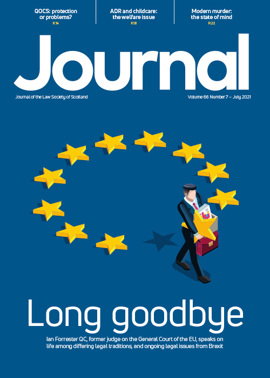Virtual proofs: anticipation and reality
Coronavirus has had and continues to have a dramatic effect on everyday life. There is no doubt that since March 2020, the pandemic has had an enormous impact on the legal profession and the way that we work, with solicitors suddenly catapulted into working remotely. One such change is the advent of virtual proofs.
I must confess that I was incredibly enthusiastic about the prospect of virtual proofs. However, I had my very first virtual sheriff court proof recently and it was a mixed experience.
Initially there were a number of advantages to be derived from utilising a virtual proof. The case involved (in part) the instruction and leading of evidence from two expert witnesses. Neither had to travel to court, nor incur any significant waiting time. Undoubtedly therefore, this resulted in significant savings. Moreover, witnesses in general were able to give evidence from their own homes or offices, and again the same benefit could be derived. Also, one witness was able to be called earlier in the day and this allowed us to progress matters more quickly. There did seem to be an overall sense of flexibility in terms of timing.
However a number of practical issues arose, and I am of the view that these need to be sufficiently addressed.
- First, putting productions to witnesses seemed to create a rather awkward issue. It did appear that when you wished to put a page, say from an expert report, to a witness, you were unable to look at the witness to gauge their response. Instead, you had to look at the page of the report on the screen in front of you. In such circumstances it was impossible to gauge the witness's body language or demeanour. By the same token, the witness might have difficulty in engaging with the agent who was conducting either the examination in chief or cross examination. It did rather appear that it came down to a choice between looking at and engaging with the witness or viewing the relevant page of the production.
- Secondly, another awkward moment arose when an opposing witness could not hear me properly. This handily arose as the witness was being cross examined by me about two lines of contradictory evidence that he had given to the court. As a result of the sound issues, the impact of any cross examination was effectively lost. This was quite frustrating.
- Thirdly, and perhaps as a follow up to the previous paragraph, on occasions (although not all the time) there appeared to be a notable lag with the video. Put another way, this meant that the facial movements were out of sync in comparison to what the witness was saying. It was very difficult therefore to work out when the witness had stopped speaking. It was also difficult to gauge their facial expression(s) when giving their evidence.
- Fourthly, a witness tilted their camera to point towards their ceiling, but continued to give their evidence. I drew no adverse inference from that. However, it did mean that perhaps the effectiveness of their evidence was lost. As a corollary to that point, it was worthy of note that some witnesses did not always have their cameras switched on. Whilst not problematic in itself, it was very difficult to know how witnesses who had previously given evidence were reacting to evidence being given at the time, for example. Moreover, there was no obvious indicator as to whether any of the parties had lost their connection.
- Fifthly, it was very difficult to communicate meaningfully with the client. Normally in a proof the client will be seated beside you at the table. If any issues arise, you are immediately available if they wish to ask you any questions or raise any other matters. In my own experience with the virtual proof, however, it was very difficult to maintain that link. To be fair, the client was able to email me at points during the proof (which was helpful), but it is in no way comparable to being able to take instructions from a client who is personally present with you.
- Sixthly, perhaps my worst fear is confidentiality potentially being compromised. It may be lack of technical knowledge on my own part, but my fear with using virtual proofs is the potential for them to be screen recorded and for the content (or part of it) to be posted on social media by a party or a witness. There is no doubt that such conduct would constitute contempt of court. However, that does not mean to say it would not happen. It may be that the courts do have a way of spotting if the proceedings are being screen recorded, but I wish to raise this important point nonetheless.
In conclusion, it is quite clear that there are many advantages to be derived from the use of virtual proofs. Undoubtedly, there are significant financial savings to be made given the obvious ability to forego travel time and much waiting time. However, my own experiences suggest that a number of issues need to be looked at – especially if virtual proofs are to be with us at least for the foreseeable future.
Perspectives
Features
Briefings
- Civil court: Final judgment
- Licensing: The shadow of criminal convictions
- Tax: Towards global rules for global businesses
- Immigration: Deporting the reformed character
- Coronavirus Acts: What does the new bill keep in force?
- Property: PSG at 20: still going strong
- In-house: Dealing at the cutting edge






